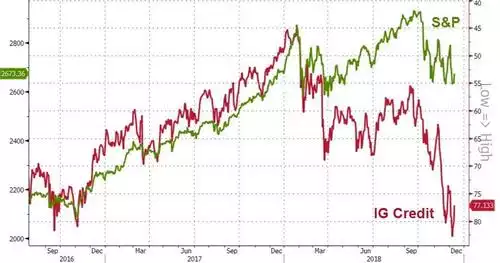Corporate Bonds Send Warning
News
|
Posted 14/12/2018
|
5962
Yesterday we discussed the effects of QE, now being unwound as QT, part of which was starving the market of yield and forcing it to look elsewhere for income. One of those channels was corporate bonds.
From 2008 to today the US corporate bond market has more than doubled from $3.2 trillion to over $7 trillion. Higher yields of course come hand in hand with higher risk. Bonds are rated by the big rating agencies (S&P, Moody’s, Fitch, etc). The higher the rating the lower the yield, the lower the rating the more risk. They are then grouped –investment grade and junk. Of that over $7 trillion in corporate bonds, around half is considered investment grade (IG). BBB is the lowest rating for IG bonds (i.e. one step above junk) and that has been where we’ve seen the biggest growth with it accounting for 58% of the market. With such growth comes leverage, and nearly a third of all that BBB debt is leveraged at 4x or above. This year (at the end of the red arrow below) is on track to be the worst performing year for IG bonds since, you guessed it, the GFC (the prominent blue line dipping low):

It’s a similar story at the CCC (junk) level where those price drops have translated into yields climbing to 11.5%, well above the 8% coupon rate they’ve been ‘sold’ on. Over a third of those CCC bonds mature in the next 4 years and those issuing companies will therefore need to pay out that debt or refinance at the higher rates, both of which require more surplus cash in a weak environment. The market can see this coming and the two biggest junk bond ETF’s have seen a record $10 billion in shorting (selling options) in the last few weeks, meaning 59% of the outstanding shares in those ETF’s are sold short! Such is the turn in sentiment in the market, that figure was only 35% in September.
IG bonds have shown to be a leading indicator in equities markets and the current chart should be ringing alarm bells:

We’ve discussed before the record level of corporate debt at present and the fact a lot of it stems from buying back shares to boost share prices. It’s simply not sustainable. The GE scare has also had many analysts worried a lot of IG debt is headed for the Junk pile and the implications of that as well. Even ex Fed chair Janet Yellen recently stated:
“Corporate indebtedness is now quite high and I think it’s a danger that if there’s something else that causes a downturn, that high levels of corporate leverage could prolong the downturn and lead to lots of bankruptcies in the non-financial corporate sector.”
Lance Roberts of RealInvestmentAdvice.com maps out where to from here:
“In other words, with rates rising, economic growth slowing (debt is serviced from revenues), and the health of balance sheets deteriorating (BBB is one notch above “junk”) the risk of an “event-driven” crisis is real. All it will take is a significant decline in asset prices to spark a cascade of events that even monetary interventions may be unable to stem. As stock prices decline:
- Consumer confidence falls further eroding economic growth
- The $4 Trillion pension problem is rapidly exposed which will require significant government bailouts.
- When prices decline enough, margin calls are triggered which creates a liquidation cascade.
- As prices fall, investors and consumers both contract further pushing the economy further into recession.
- Aging baby-boomers, which are vastly under-saved will become primarily dependent on social welfare which erodes long-term economic growth rates.
With the Fed tightening monetary policy, and an errant Administration fighting a battle it can’t win, the timing of the next recession has likely been advanced by several months.
The real crisis comes when there is a “run on pensions.” With a large number of pensioners already eligible for their pension, the next decline in the markets will likely spur the “fear” that benefits will be lost entirely. The combined run on the system, which is grossly underfunded, at a time when asset prices are dropping will cause a debacle of mass proportions. It will require a massive government bailout to resolve it.
But it doesn’t end there. Consumers are once again heavily leveraged with sub-prime auto loans, mortgages, and student debt. When the recession hits, the reduction in employment will further damage what remains of personal savings and consumption ability. The downturn will increase the strain on an already burdened government welfare system as an insufficient number of individuals paying into the scheme is being absorbed by a swelling pool of aging baby-boomers now forced to draw on it. Yes, more Government funding will be required to solve that problem as well.
As debts and deficits swell in the coming years, the negative impact to economic growth will continue. At some point, there will be a realization of the real crisis. It isn’t a crash in the financial markets that is the real problem, but the ongoing structural shift in the economy that is depressing the living standards of the average American family. There has indeed been a redistribution of wealth in America since the turn of the century. Unfortunately, it has been in the wrong direction as the U.S. has created its own class of royalty and serfdom.
But most importantly, that is how interest rates remain low for a very long-time.
While there is little left for interest rates to fall in the current environment, there is no ability for rates to rise before you push the economy back into recession. Of course, you don’t have to look much further than Japan for a clear example of what I mean.”